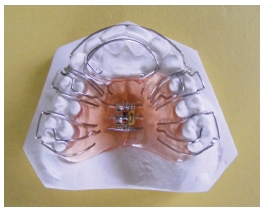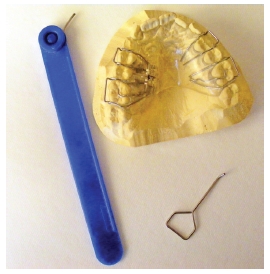Chapter 7
Removable appliances
Teeth move as a reaction to forces applied to them.
There are two main types of orthodontic appliance:
- removable
- fixed
Sometimes a fixed or removable appliance can have similar aims, for example:
- A fixed appliance for maxillary expansion
- a removable appliance with a central widening screw in the midline for expansion (Figures 7.1 and 7.2)
Some treatments can be completed by using only removable appliances.
Removable appliances are sometimes used prior to a fixed appliance.
Patients will often incorrectly refer to an active removable appliance as a ‘retainer’.
At the completion of any active treatment, there is a period of retention for which retainers are made. Occasionally, if treatment is with removable appliances, these can be made passive to act as retainers.
Retainers are passive appliances and maintain the position of the teeth after treatment.
Figure 7.1 Removable appliance with expansion screw.

Figure 7.2 Expansion screw and choice of key types.

Removable appliances can move teeth using labial bows, screws, springs and elastics, and have been very popular in the UK, but following the development of fixed appliance therapy they have become less used.
The functional appliance is usually a removable appliance in as far as it can be taken in and out, but has different aims of treatment and is discussed in Chapter 11.
Removable appliances move teeth by tipping or tilting them whilst fixed appliances have the ability to move teeth bodily (crown and root) without tipping.
Removable appliances can be used:
- in the maxilla
- in the mandible
- both in the maxilla and in the mandible at the same time
but are more often used in the upper arch.
They are mostly used for the treatment of simple malocclusions or for short periods of time as part of an overall plan.
They are most commonly used:
- as an anterior bite plane (to reduce an increased overbite)
- to move incisors over the bite (usually in the mixed dentition)
- to tip teeth labially, lingually, mesially or distally
- to provide freeway space to correct an occlusal problem (disengage the occlusion)
- to widen an arch to correct a crossbite by using inbuilt expansion screws
Like any other appliance, they sometimes need to be repaired. In the case of removable appliances, this means the appliance has to be taken from the patient and sent to the laboratory. The breakage may be severe enough to make the appliance irreparable such that it is simpler for the technician to make a new appliance.
Removable appliances can be used in conjunction with the extraction of teeth.
This provides space into which teeth can be moved in order to reduce crowding.
To be successful, removable appliances must:
- be worn full time as instructed
- be worn by a keen patient
- be fitted in a clean mouth
In addition to removable appliances with active components which are used to move teeth, they are also used as:
- anti-habit appliances (these appliances are used to deter digit sucking)
- stimulation plates to encourage eruption, where a pad of acrylic presses over an eruption site, to encourage a late erupting tooth to appear
- space maintainers – worn to prevent teeth drifting
- retainers
The components are:
- A – anchorage
- R – retention
- A – active
- B – baseplate
The removable appliance needs to have:
- retention (to make sure the appliance is held in place), e.g. clasps/cribs
- parts to move the teeth, e.g. springs or screws
- a baseplate that fits around the teeth securely and carries all the metal components and also provides anchorage
ADVANTAGES – WHAT THEIR BENEFITS ARE
They:
- are, for an experienced technician, simple to make
- are easy to wear (for children)
- can reduce an overbite
- can tilt teeth
- need very little chairside time to fit
- make oral hygiene easier by being removable
- are less visible
DISADVANTAGES – WHAT THEY CANNOT ACHIEVE
- cannot de-rotate teeth
- cannot move the root bodily, can only tilt the position of a tooth
- can be taken out and not worn
PARTS OF A REMOVABLE APPLIANCE
Baseplate
- made of acrylic
- provides stability (anchorage) for those teeth not being moved
- carries all the active springs, screws and wires that will put force on teeth
- carries all the retention components, e.g. clasps/cribs
Often, the baseplate (Figure 7.3) can include the following.
Bite plane
This can be either:
- Anterior
- acrylic build-up behind the upper front teeth to ‘jack open’ the bite so that the overbite can be reduced. Because the low/>
Stay updated, free dental videos. Join our Telegram channel

VIDEdental - Online dental courses


